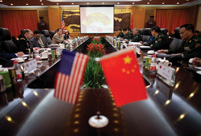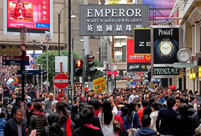 'Jin' named the word of the year by cross-strait netizens
'Jin' named the word of the year by cross-strait netizens Chinese scientific expedition goes to build new Antarctica station
Chinese scientific expedition goes to build new Antarctica station
 Chinese naval escort fleet conducts replenishment in Indian Ocean
Chinese naval escort fleet conducts replenishment in Indian Ocean 17th joint patrol of Mekong River to start
17th joint patrol of Mekong River to start China's moon rover, lander photograph each other
China's moon rover, lander photograph each other Teaming up against polluters
Teaming up against polluters
At a recent central urbanization work conference the Chinese leadership has pledged proactive yet steady progress in promoting human-centered urbanization, as it looks to balance urban-rural development and encourage domestic demand.
China will emphasize urbanization in the less-developed central, west and northeast regions, with the aim of making growth more balanced, according to a statement released after the highest-level meeting it has ever convened on urbanization, which ended on Dec. 13.
According to the statement, efforts will be made to build up a diverse and sustainable funding mechanism for the initiative. The conference stressed the importance of green and low-carbon development in future urbanization.
After years of rapid development, the urbanization process in China is ready to begin a new phase. The conference offered responses to the three big concerns in the new urbanization plan.
1.Where are the rural people to go?
At the end of 2012, China had 710 million urban residents. For the first time in China's history, its urban population exceeded its rural population, with city-dwellers accounting for 51.27 percent of the total population.
However, only 35% of the Chinese population possesses a city hukou, which qualifies a resident for better social welfare services than a rural hukou.
About 250 million former farmers who are now migrant workers have moved to cities in the hope of being recognized as an urban resident, leaving parents and children in rural areas. As larger-scale urbanization is planned and land reforms are rolled out, more farmers are expected to move to the cities.
"China’s urbanization must focus on quality development rather than immediate results," says Hong Xu, Minister of the Chinese Ministry of International Economic Exchange Center. According to a statement released after the central urbanization work conference, the primary task is to enable migrant workers to gain urban status in an orderly manner.
"People who are capable of maintaining a stable job and life in the city make a contribution to the urban economy and to social development. Government should allow these people to gain urban status first," said Chen Fei, an associate researcher of the Chinese Academy of Social Sciences.
2.Where will the funds come from?
Chen believes that urbanization will be a long process. Due to historical debts and financial constraints, urbanization should be conducted in an active and steady manner. With the improvement of the funding mechanism and increasing financial resources, incremental problems can then be solved by the ‘invisible hand’ of the market.
Accelerating urbanization requires a lot of money. The national development bank estimates that the capital demands of China's investment in urbanization will reach 25 trillion yuan (4.1 trillion US dollars) in the next three years. Since financial resources are limited, Xu Hongcai is of the view that if the government relies only on government funds to support the process of urbanization, deficit spending will be high, development will be unsustainable, and the associated risks will be enormous.
It was pledged at the urbanization conference that diverse and sustainable funding mechanisms will be developed to finance policies.
Zhang Liqun, a macroeconomic researcher of Development Research Center of the State Council said: "Currently, large amounts of private capital cannot find suitable investment channels. As long as the government provides fair opportunities and creates a favorable market environment, financial resources will be able to play a useful role in liberating all levels of social forces."
3.How best to use land resources?
China has a huge population, but is provided with relatively poor per capita land resources. With the advance of urbanization, the average annual reduction of arable land is over 40 hectares. China’s arable land approximates to 120 million hectares, and is approaching a dangerous limit.
"Blind and excessive land exploitation in the course of China's urbanization over the past 30 years has contributed in part to the sharp decrease in the country's arable land area and may pose a future threat to food security," said Chen Fei.
The conference report reflected this concern with China’s food security, demanding that there be a "red line" fixed for the quantity and quality of arable land left available for farming.
Xu said that the Chinese leadership’s attitude is very clear that a minimum limit of arable land will not be breached. Urbanization is expected to make up for the loss of farmland through intensified use of land resources. Under the principle of overall management, the government should focus on improving the efficiency of urban land utilization.
 Commemorate 120th birth anniversary of Mao Zedong
Commemorate 120th birth anniversary of Mao Zedong Female soldiers of PLA Marine Corps in training
Female soldiers of PLA Marine Corps in training Chinese cities to have a very grey Christmas as smog persists
Chinese cities to have a very grey Christmas as smog persists China and U.S. - the national image in each other’s eyes
China and U.S. - the national image in each other’s eyes The Liaoning's combat capability tested in sea trial
The Liaoning's combat capability tested in sea trial Chinese pole dancing team show their moves in snow
Chinese pole dancing team show their moves in snow Rime scenery in Mount Huangshan
Rime scenery in Mount Huangshan Ronnie O'Sullivan: My children mean the world to me
Ronnie O'Sullivan: My children mean the world to me Shopping in Hong Kong: a different picture
Shopping in Hong Kong: a different picture The buzzwords in 2013
The buzzwords in 2013 Top 10 domestic news of 2013
Top 10 domestic news of 2013 Red crabs begin annual migrations in Australia
Red crabs begin annual migrations in Australia Artifacts retrieved from West Zhou Dynasty
Artifacts retrieved from West Zhou Dynasty Aftermath of Volgograd railway station blast
Aftermath of Volgograd railway station blast Fleet hits targets in training
Fleet hits targets in trainingDay|Week|Month